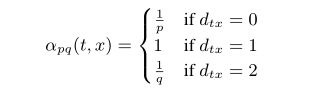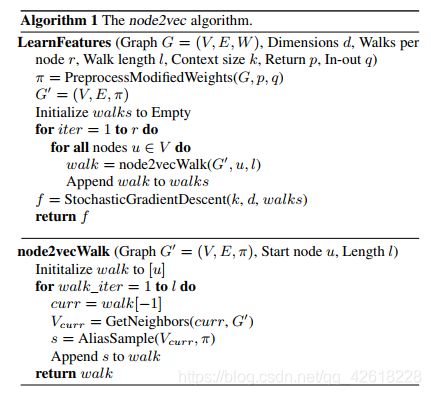node2vec的一些理解
node2vec
node2vec也是一种网络嵌入的表示方法,它是基于DeepWalk的基础上进行改进的。主要改进的地方在于它在随机游走的过程中加入了一个权重,使得游走可以采用深度优先和广度优先的策略进行游走。
Search bias α
使得随机游走产生片偏差的最简单的方法是根据静态边缘权重 W v x W_vx Wvx进行采样,在未加权图的情况下 W v x = 1 W_{vx}=1 Wvx=1,但是这并不能解释我们的网络结构,并且指导我们探索不同的网络邻居。此外,与BFS和DFS不同,BFS和DFS是分别适用于结构等价性和同质性的极端抽样范式,我们的随机游动应该适应这样一个事实:这些等价性的概念不是竞争的或排他的,而现实世界的网络通常表现出两者的混合。
所以我们定义了一个2阶随机游走,并且定义了两个参数分别是p和q用来指导我们进行随机游走。

假设我们有一个随机游走已经穿过了(t,v)节点并且现在暂时居住在如图所示的V节点。我们现在要考虑下一步怎么走,那么我们可以使用边(v,x)的转移概率 Π v x Π_{vx} Πvx用来引导我们从v的下一步怎么走。我们假定了一个转移概率 Π v x = α p q ( t , x ) ∗ W v x Π_vx=α_{pq}(t,x)*W_{vx} Πvx=αpq(t,x)∗Wvx 其中 α p q ( t , x ) α_{pq}(t,x) αpq(t,x)定义如下:

其中 d t x d_{tx} dtx表示t和x之间的最短路径,注意的是 d t x d_{tx} dtx的取值一定是{0,1,2}的其中一个,所以p,q两个参数能够很好的指导游走。
例如当终点为t时,我们相当于往回走了,不为t时我们则是向外游走或是向深游走。
返回参数 p:p代表我们游走时重复游走的可能性,如果我们把p设置为一个很高的值(> max(q,1))则可以用来确保我们有极小的可能性重复游走一个节点(除非下一个节点没有其他邻居)。这个策略鼓励我们适度探索,而不是产生冗余。另一方面,如果我们把p的值设为很小(< min(q,1)),则他会使得walk接近我们的起始位置。
In-Out参数 q:他更倾向于访问距离节点t更远的节点,这种行为反映了鼓励向外探索的DFS。然而,这里的一个本质区别是,我们在随机行走框架中实现了类似DFS的探索。
node2vec 算法流程

如上图所示,我们一开始主要是要进行我们的静态权重的赋值,用它来引导我们继续随机游走得到随机游走序列,然后我们将得到的序列利用skip-gram模型进行嵌入,最后得到嵌入矩阵。
def _precompute_probabilities(self):
"""
Precomputes transition probabilities for each node.
"""
d_graph = self.d_graph
nodes_generator = self.graph.nodes() if self.quiet \
else tqdm(self.graph.nodes(), desc='Computing transition probabilities')
for source in nodes_generator:
# Init probabilities dict for first travel
if self.PROBABILITIES_KEY not in d_graph[source]:
d_graph[source][self.PROBABILITIES_KEY] = dict()
for current_node in self.graph.neighbors(source):
# Init probabilities dict
if self.PROBABILITIES_KEY not in d_graph[current_node]:
d_graph[current_node][self.PROBABILITIES_KEY] = dict()
unnormalized_weights = list()
d_neighbors = list()
# Calculate unnormalized weights
for destination in self.graph.neighbors(current_node):
p = self.sampling_strategy[current_node].get(self.P_KEY,
self.p) if current_node in self.sampling_strategy else self.p
q = self.sampling_strategy[current_node].get(self.Q_KEY,
self.q) if current_node in self.sampling_strategy else self.q
if destination == source: # Backwards probability
ss_weight = self.graph[current_node][destination].get(self.weight_key, 1) * 1 / p
elif destination in self.graph[source]: # If the neighbor is connected to the source
ss_weight = self.graph[current_node][destination].get(self.weight_key, 1)
else:
ss_weight = self.graph[current_node][destination].get(self.weight_key, 1) * 1 / q
# Assign the unnormalized sampling strategy weight, normalize during random walk
unnormalized_weights.append(ss_weight)
d_neighbors.append(destination)
# Normalize
unnormalized_weights = np.array(unnormalized_weights)
d_graph[current_node][self.PROBABILITIES_KEY][
source] = unnormalized_weights / unnormalized_weights.sum()
# Save neighbors
d_graph[current_node][self.NEIGHBORS_KEY] = d_neighbors
# Calculate first_travel weights for source
first_travel_weights = []
for destination in self.graph.neighbors(source):
first_travel_weights.append(self.graph[source][destination].get(self.weight_key, 1))
first_travel_weights = np.array(first_travel_weights)
d_graph[source][self.FIRST_TRAVEL_KEY] = first_travel_weights / first_travel_weights.sum()
具体代码实现如图所示,我们首先进入函数利用d_graph生成一个字典,在其中加入概率标签,然后我们通过循环节点以及节点的邻居对权重进行赋值,同时对我们的p,q进行策略的更改。最后的d_graph则是我们修改之后的带有我们设置的权重的重要参数,然后我们将d_graph带入到我们的游走序列生成的函数当中去。
def parallel_generate_walks(d_graph: dict, global_walk_length: int, num_walks: int, cpu_num: int,
sampling_strategy: dict = None, num_walks_key: str = None, walk_length_key: str = None,
neighbors_key: str = None, probabilities_key: str = None, first_travel_key: str = None,
quiet: bool = False) -> list:
"""
Generates the random walks which will be used as the skip-gram input.
:return: List of walks. Each walk is a list of nodes.
"""
walks = list()
if not quiet:
pbar = tqdm(total=num_walks, desc='Generating walks (CPU: {})'.format(cpu_num))
for n_walk in range(num_walks):
# Update progress bar
if not quiet:
pbar.update(1)
# Shuffle the nodes
shuffled_nodes = list(d_graph.keys())
random.shuffle(shuffled_nodes)
# Start a random walk from every node
for source in shuffled_nodes:
# Skip nodes with specific num_walks
if source in sampling_strategy and \
num_walks_key in sampling_strategy[source] and \
sampling_strategy[source][num_walks_key] <= n_walk:
continue
# Start walk
walk = [source]
# Calculate walk length
if source in sampling_strategy:
walk_length = sampling_strategy[source].get(walk_length_key, global_walk_length)
else:
walk_length = global_walk_length
# Perform walk
while len(walk) < walk_length:
walk_options = d_graph[walk[-1]].get(neighbors_key, None)
# Skip dead end nodes
if not walk_options:
break
if len(walk) == 1: # For the first step
probabilities = d_graph[walk[-1]][first_travel_key]
walk_to = np.random.choice(walk_options, size=1, p=probabilities)[0]
else:
probabilities = d_graph[walk[-1]][probabilities_key][walk[-2]]
walk_to = np.random.choice(walk_options, size=1, p=probabilities)[0]
walk.append(walk_to)
walk = list(map(str, walk)) # Convert all to strings
walks.append(walk)
if not quiet:
pbar.close()
return walks
生成游走的序列的代码如上图所示,我们可以看出将d_graph当中的概率取出,然后带入到np.random.choice这个函数当中去,这样我们就是按照一定的概率进行随机游走,而游走的概率是可以通过修改p,q两个参数进而进行修改的。最后我们则将我们得到的游走序列walks带入skip-gram模型进行训练,得到我们想要的嵌入矩阵。
def fit(self, **skip_gram_params):
"""
Creates the embeddings using gensim's Word2Vec.
:param skip_gram_params: Parameteres for gensim.models.Word2Vec - do not supply 'size' it is taken from the Node2Vec 'dimensions' parameter
:type skip_gram_params: dict
:return: A gensim word2vec model
"""
if 'workers' not in skip_gram_params:
skip_gram_params['workers'] = self.workers
if 'size' not in skip_gram_params:
skip_gram_params['size'] = self.dimensions
return gensim.models.Word2Vec(self.walks, **skip_gram_params)